Got a kitchen that’s smaller than your neighbor’s walk-in closet? Yeah, I feel you. I’ve been there, staring at my shoebox-sized kitchen, wondering how the heck I’m supposed to cook anything more complex than instant ramen. But here’s the thing – small kitchens can be absolute game-changers when you know the right tricks.
I’ve spent years figuring out how to make tiny spaces work harder than a caffeinated college student during finals week. Trust me, these ideas will transform your cramped cooking corner into something that actually makes sense.
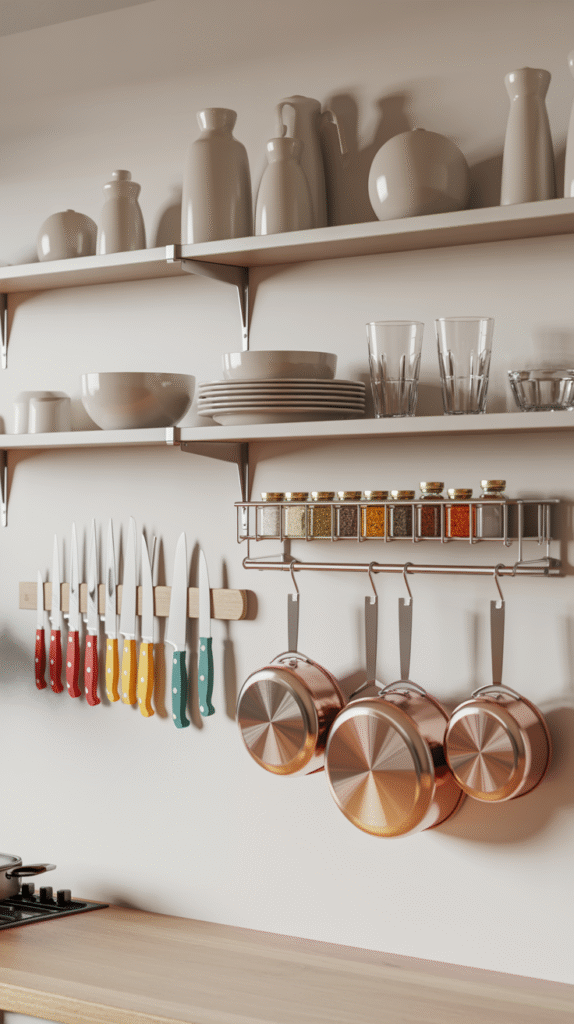
Go Vertical Like Your Life Depends on It
Wall-Mounted Storage Solutions
Your walls are basically free real estate that you’re probably ignoring. I started mounting everything I could on my kitchen walls, and honestly? It’s like discovering hidden square footage.
Here’s what you can hang up there:
- Magnetic knife strips (goodbye, counter clutter!)
- Spice racks that actually fit your space
- Pot rails that make you feel like a professional chef
- Floating shelves for dishes and glasses
The trick is thinking of your walls as vertical cabinet space. Why let all that prime real estate go to waste when you could be storing your stuff there?
Cabinet Height Maximization
Ever notice how most people waste the space between their cabinet tops and the ceiling? That’s basically kitchen storage purgatory right there. I installed additional shelving in that dead zone, and suddenly I had room for all those appliances I only use twice a year.
Pro tip: Use attractive baskets or containers up there so it doesn’t look like a storage unit exploded in your kitchen.
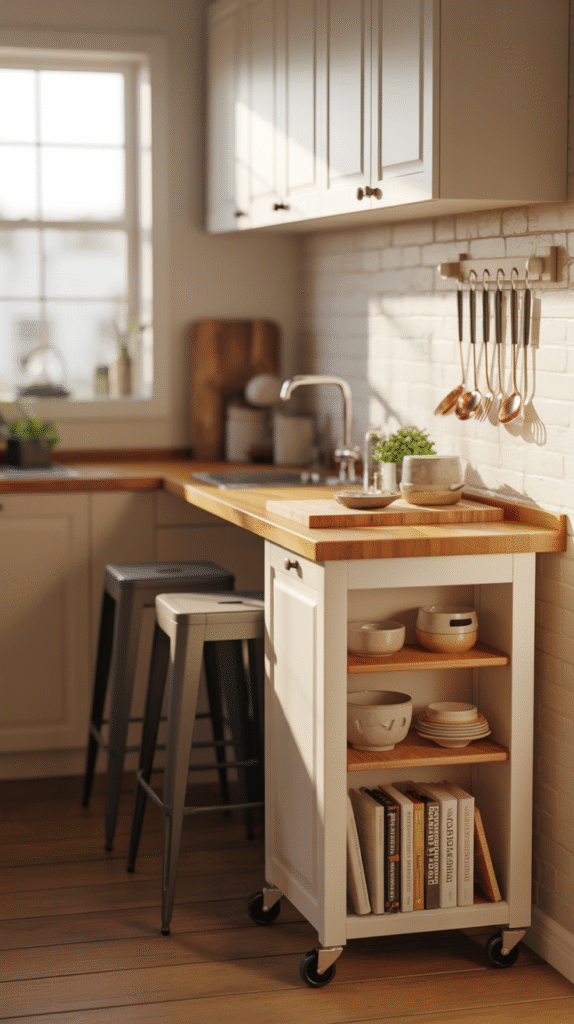
Multi-Functional Furniture Is Your Best Friend
Kitchen Islands That Actually Work
Think you can’t fit an island in your tiny kitchen? Think again! I found a narrow rolling cart that works as prep space, storage, and a breakfast bar all in one. It’s like the Swiss Army knife of kitchen furniture.
Look for islands with:
- Built-in storage underneath
- Wheels for easy movement
- Extendable surfaces for extra prep space
- Hooks on the sides for utensils
Dining Solutions That Don’t Eat Your Space
Drop-leaf tables are seriously underrated. I installed one against my wall, and when I’m not eating, it folds down to basically nothing. When friends come over (rare, but it happens :)), I just flip it up and voilà – instant dining room.
Bar-height tables also work wonders because you can tuck stools completely underneath them.
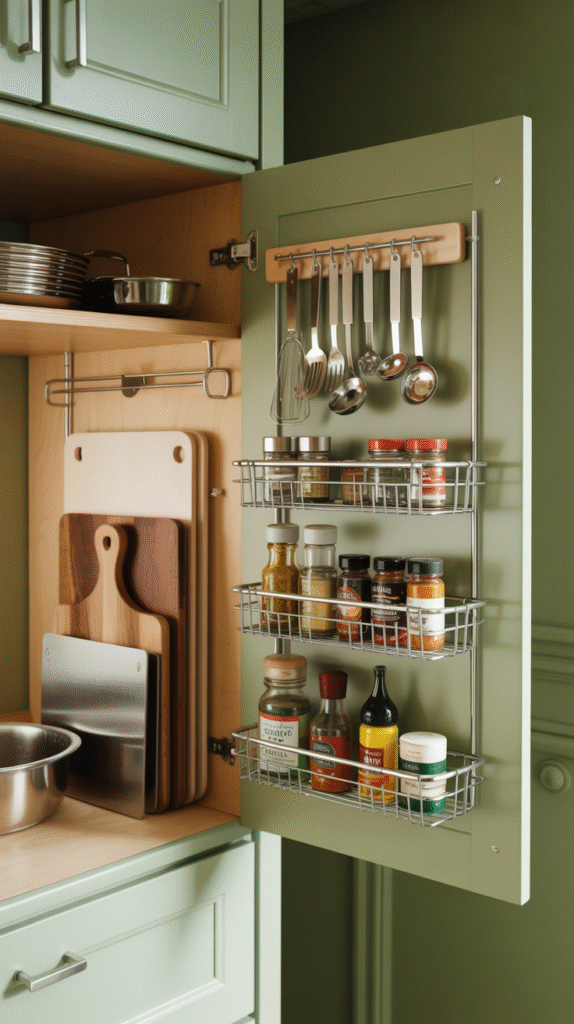
Smart Storage Hacks That’ll Blow Your Mind
Inside Cabinet Door Magic
The inside of your cabinet doors is prime real estate that most people completely ignore. I attached slim racks to hold cutting boards, baking sheets, and even cleaning supplies. It’s like finding a secret compartment in your kitchen.
What you can store on cabinet doors:
- Measuring cups and spoons
- Aluminum foil and plastic wrap
- Cleaning supplies
- Spice collections
Drawer Organizers That Actually Organize
Random kitchen drawers are basically black holes where utensils go to die. I invested in proper drawer dividers, and now I can actually find my can opener without conducting an archaeological dig.
Adjustable dividers are worth their weight in gold because you can customize them for your specific needs.
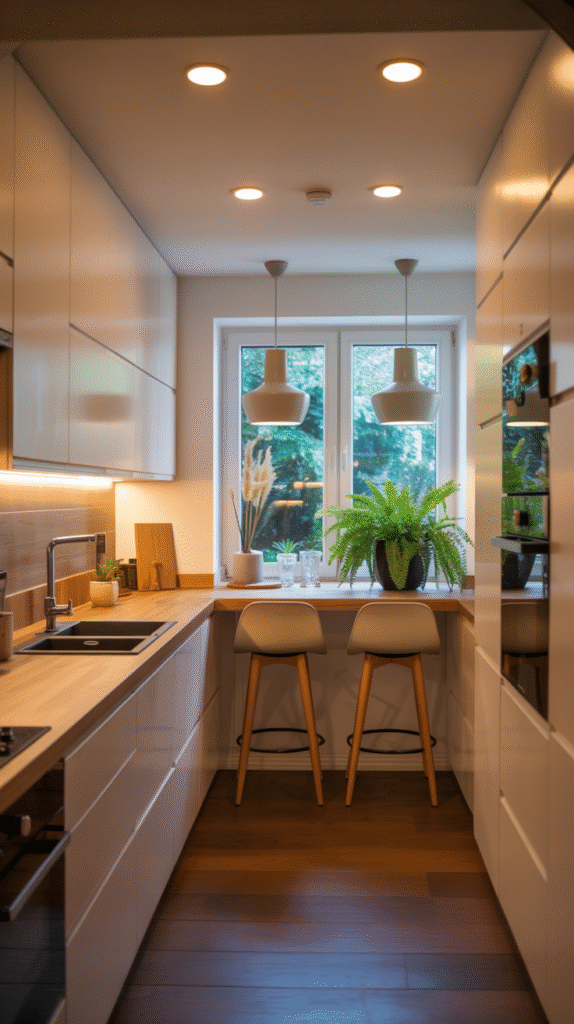
Light and Color: The Optical Illusion Game
Strategic Lighting Placement
Dark kitchens feel even smaller than they actually are. I added under-cabinet LED strips, and the difference was like night and day. Good lighting makes everything feel more spacious and welcoming.
Layer your lighting with:
- Under-cabinet task lighting for prep work
- Pendant lights over islands or bars
- Recessed lighting for general illumination
- Natural light whenever possible
Color Psychology in Small Spaces
Light colors reflect light and make spaces feel bigger – it’s not rocket science, but it works. I painted my tiny kitchen in soft whites and light grays, and suddenly it didn’t feel like a closet anymore.
Bold accent colors can work too, but use them sparingly. A bright backsplash or colorful appliances can add personality without overwhelming the space.
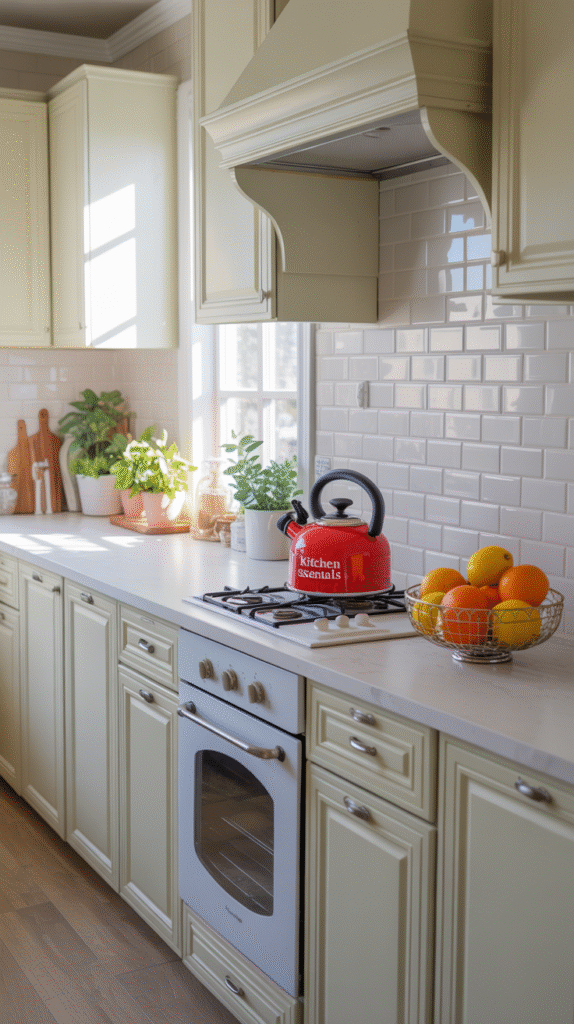
Appliance Hacks for Space-Challenged Kitchens
Compact Appliances That Don’t Compromise
Not all small appliances are created equal. I learned this the hard way after buying a “compact” microwave that was about as compact as a small refrigerator. Size matters, but so does functionality.
Look for appliances that:
- Stack or nest when not in use
- Serve multiple purposes (like toaster oven combos)
- Mount under cabinets to save counter space
- Fit in drawers when possible
Hidden Appliance Storage
Ever wonder where to put that stand mixer you use once a month? I created an appliance garage in one of my lower cabinets with a rolling shelf. Now my heavy appliances live there until I need them.
Pull-out shelves in lower cabinets make accessing stored appliances way easier than crawling around on your hands and knees.
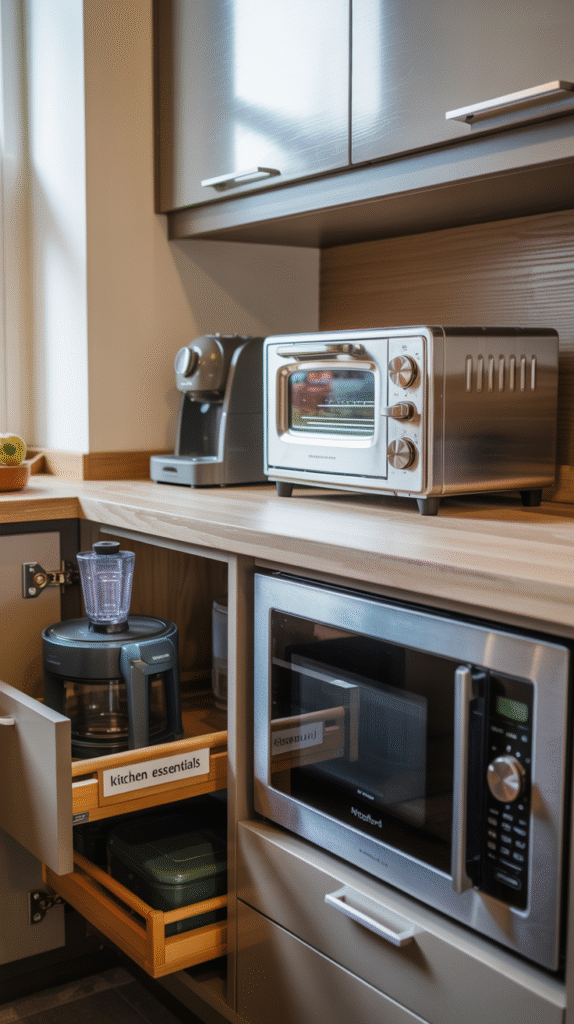
Counter Space Optimization Strategies
The Art of Counter Clearing
Counter space in tiny kitchens is more precious than parking spots in Manhattan. I made a rule: if it doesn’t get used daily, it doesn’t live on the counter. Period.
Keep only these essentials visible:
- Coffee maker (because priorities)
- Dish soap and sponge
- Salt and pepper
- Maybe one decorative item (if you’re feeling fancy)
Temporary Work Surfaces
Sometimes you need more prep space than your kitchen can provide. I got a cutting board that fits over my sink – instant extra counter space when I need it, and it stores flat when I don’t.
Rolling carts can also provide temporary work surfaces that disappear when not needed.
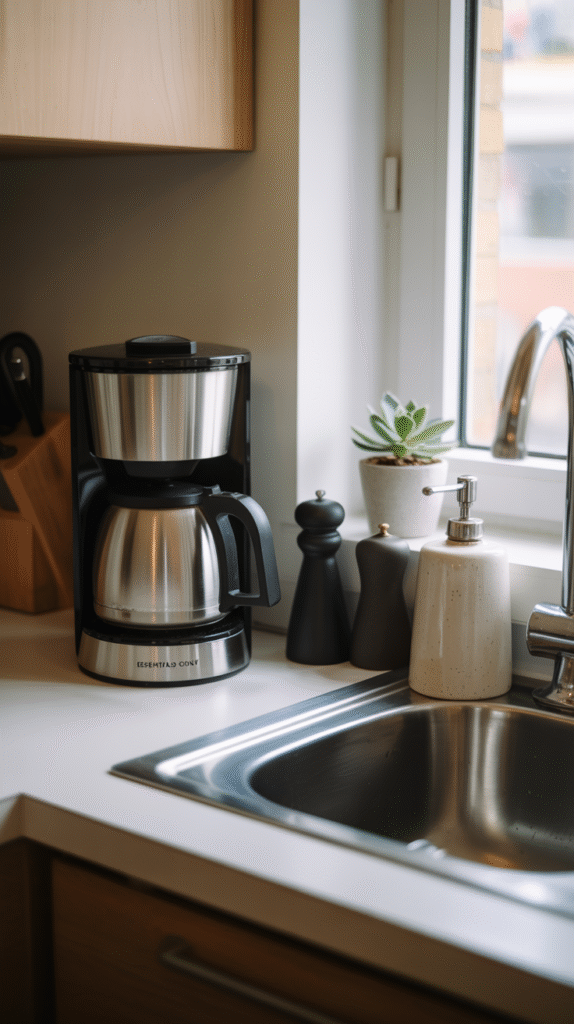
Organization Systems That Actually Stick
The One-In-One-Out Rule
This might sound harsh, but it works: for every new item that enters your kitchen, something else has to leave. I started following this rule, and my tiny kitchen stopped feeling like a storage unit.
Designated Zones
Even in tiny kitchens, you need designated areas for different activities. I created specific zones for:
- Prep work (near the sink)
- Cooking (around the stove)
- Storage (in cabinets and pantry)
- Cleaning (near the dishwasher)
Clear boundaries between zones make your kitchen feel more organized and functional.
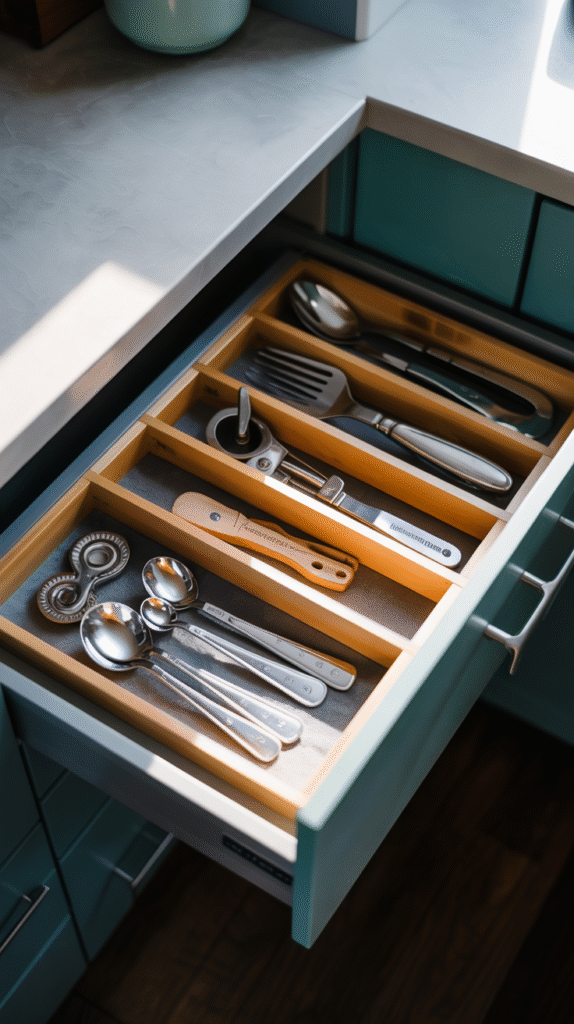
Budget-Friendly Upgrades That Make a Difference
DIY Solutions That Actually Work
You don’t need to spend a fortune to make your tiny kitchen functional. Some of my best storage solutions cost less than $20 and took an afternoon to install.
Simple upgrades include:
- Adhesive hooks for lightweight items
- Magnetic strips for knives and spices
- Tension rods for hanging cleaning supplies
- Drawer liner to keep things from sliding around
Strategic Splurges
When you do have money to spend, invest in quality storage solutions that’ll last. A good set of nested containers or a well-made spice rack will serve you for years.
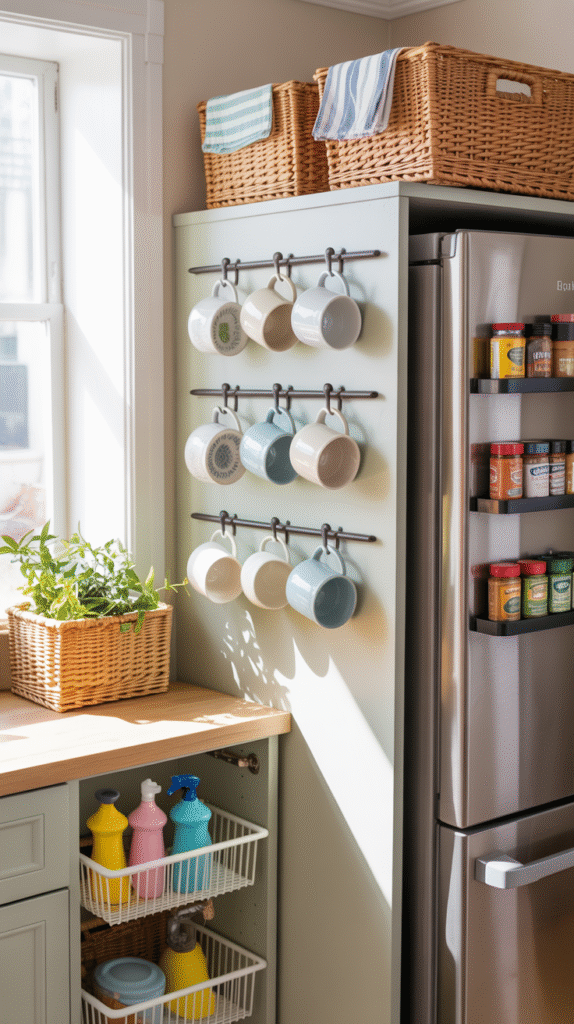
Making Your Tiny Kitchen Feel Intentional
Embrace the Cozy Factor
Here’s the truth: tiny kitchens can be incredibly charming when you stop fighting their size and start working with it. I learned to embrace the cozy, intimate feeling instead of constantly wishing for more space.
Personal Style in Small Spaces
Just because your kitchen is small doesn’t mean it can’t have personality. I added a few carefully chosen decorative elements that reflect my style without cluttering the space.
One statement piece – like a colorful backsplash or unique light fixture – can give your kitchen tons of character without overwhelming it.
The Reality Check: What Actually Works
Let’s be real for a second – not every Pinterest-worthy tiny kitchen idea actually works in real life. I’ve tried plenty of “genius” solutions that were more trouble than they were worth.
What actually works:
- Simple, accessible storage
- Multi-purpose items
- Regular decluttering
- Realistic expectations
What doesn’t work (IMO):
- Overly complicated organization systems
- Storage solutions that require acrobatics to access
- Trying to fit full-size everything into a tiny space
Your tiny kitchen doesn’t have to be perfect – it just needs to work for you. FYI, some of the most memorable meals I’ve ever cooked came from my shoebox-sized kitchen, simply because I learned to make it work 🙂
The key is working with your space instead of against it. Your tiny kitchen has potential – it just needs the right approach to unlock it.
